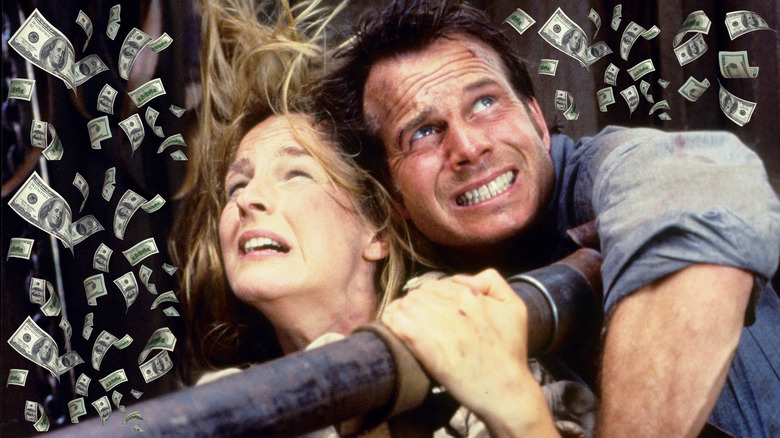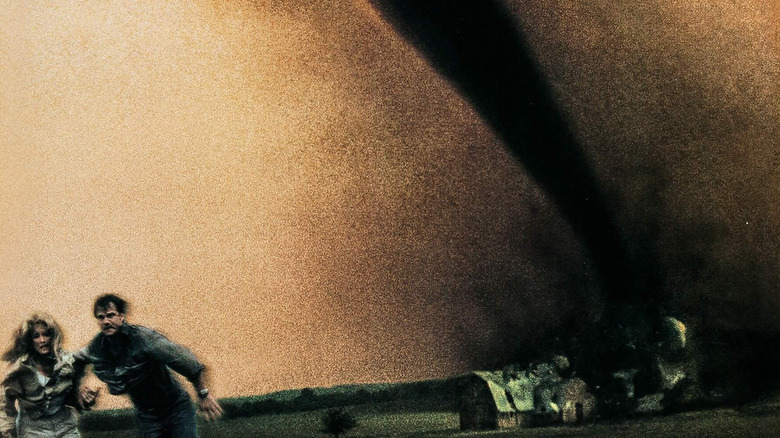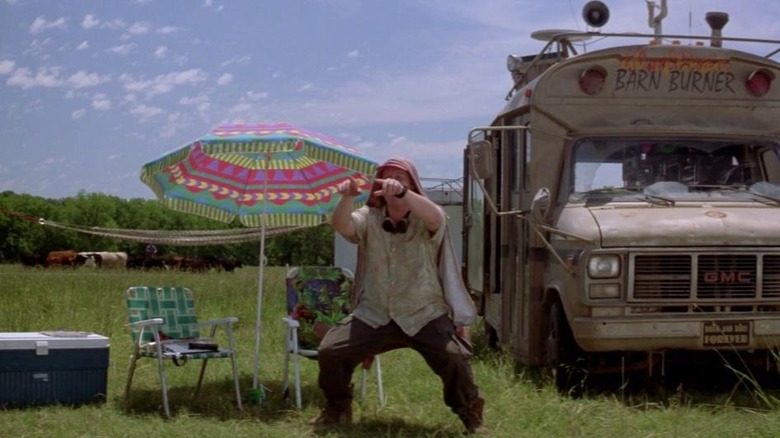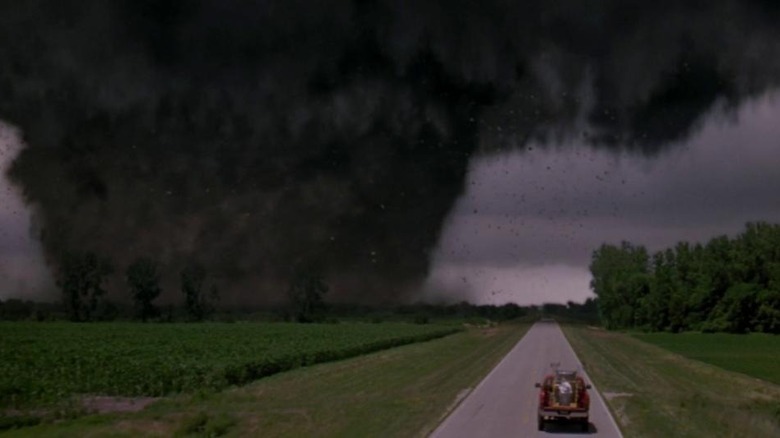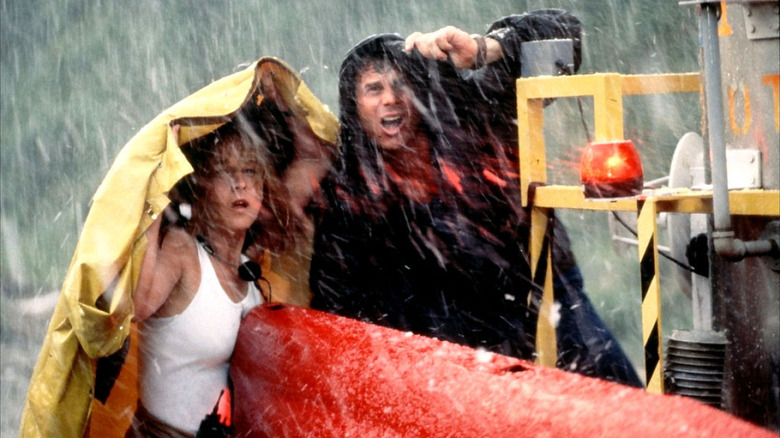Twister's Box Office Success Redefined The Summer Movie Season — Literally
(Welcome to Tales from the Box Office, our column that examines box office miracles, disasters, and everything in between, as well as what we can learn from them.)
For nearly as long as movies have been a form of mass entertainment, the disaster genre has brought excitement and thrills to the big screen, dating back to 1933's "Deluge," which picks up in the aftermath of a massive earthquake in New York. At some point, these films became big business, commanding big budgets in Hollywood. Look no further than 1998, when both "Armageddon" and "Deep Impact" opened mere months from one another, offering radically different takes on the whole asteroid colliding with the Earth scenario. The '90s also gifted us a very important entry in this enduring genre in the form of director Jan de Bont's "Twister."
Released in 1996, "Twister" became something of a phenomenon and a real marker for how technology was going to change blockbuster filmmaking forever. "Twister" made great use of the advancements in CGI that Steven Spielberg pioneered in 1993's landmark smash hit "Jurassic Park." Not coincidentally, Michael Crichton, who wrote the "Jurassic Park" novel, was involved in this film as well, as was Spielberg as an executive producer. If dinosaurs could be convincingly brought to life on screen, so too could terrifying tornadoes capable of bringing mass destruction and chaos. De Bont displayed natural disasters in ways never seen before on the silver screen, and audiences ate it up.
In this week's Tales from the Box Office, we're looking back at "Twister" in honor of the release of its legacy sequel, "Twisters." We'll go over how the film came to be, how the groundbreaking special effects were made, what happened when the movie hit theaters, how it forever changed the summer movie season, and what lessons we can learn from it all these years later. Let's dig in, shall we?
The movie: Twister
For those who may need a refresher, "Twister" unfolds as an estranged couple, Dr. Jo Harding (Helen Hunt) and Bill Harding (Bill Paxton), reunite to finalize a divorce. However, as a record series of storms emerge, Bill is roped back into his former rag-tag group of storm chasers to help deploy "Dorothy," a tornado research device that could help improve tornado warning systems and save lives.
Aside from Hunt and Paxton leading the way, de Bont assembled one heck of an ensemble, including Cary Elwes ("The Princess Bride"), Jami Gertz ("The Lost Boys"), Alan Ruck ("Ferris Bueller's Day Off"), future "Tar" director Todd Field, and the late Philip Seymour Hoffman (perhaps best known for "Scent of a Woman" at the time). Looking back, it truly was an ensemble for the ages. One that could have included country music superstar Garth Brooks, it's worth noting, but he passed because he didn't want to play second fiddle to the movie's real stars: the tornadoes. In any event, the humans on screen were just as compelling as what they were facing down, which is a big part of this movie's secret sauce.
"It really showed the sort of things that you could do in digital," Industrial Light and Magic (ILM) VFX supervisor Ben Snow told The Ringer in 2020. Snow was working as a digital effects artist at the time. ILM, dating back to its groundbreaking work on "Star Wars," has long been held as the gold standard for visual effects in Hollywood. Naturally, they were brought on board to make these natural disasters through digital means.
ILM's Habib Zargarpour worked with the company's creative director Dennis Muren for 10 weeks to create the test footage that would prove this could be done. Zargarpour used software to create millions of tiny digital particles that he could manipulate to craft a CGI tornado. "You could script behaviors for every single particle. I was basically creating particles out of statistics. Forming some volume," he explained to The Ringer.
Selling Twister to Hollywood
Using that test footage, Spielberg and Kathleen Kennedy, who now serves as the President of Lucasfilm under Disney, were able to sell "Twister" to Warner Bros. and Universal, with the former handling domestic rights and the latter distributing the film internationally. De Bont, meanwhile, was coming off of his feature directorial debut "Speed," which became a huge hit in 1994. He was brought on board to tackle this much, much bigger beast, which was being written by Crichton and his wife Anne-Marie Martin. The script was eventually rewritten numerous times by the likes of Joss Whedon ("Buffy the Vampire Slayer") and Jeff Nathanson ("Rush Hour 2"), among others.
In crafting "Jurassic Park," the visual artists were bringing extinct creatures back to life. The challenge with this film is that they were crafting a digital version of a thing that exists in contemporary nature, meaning they absolutely had to get it right. That was no small challenge, and as one might expect, such work gets expensive. That's to say nothing of all of the practical effects work that de Bont shot, which was particularly hard on the cast. "We all got bruises and cuts," Elwes said to Entertainment Weekly in 1996 while promoting the release.
In that same EW piece, it's explained that the original budget for the film was pegged in the $70 million range — still a tremendous sum for the time. However, last minute-reshoots and overtime related to the visual effects added a significant amount to the budget, bringing it closer to $90 million. For context, James Cameron's "True Lies" became the first movie to ever cost more than $100 million in 1995, so this was truly at the high end of what was being spent on a single production at the time. Fortunately for all involved, it would prove to be money well spent.
The financial journey
The Hollywood landscape 30 years ago was much different, so much that it can be hard to remember. Superheroes were not the dominant force they are now, franchise-obsession was not running rampant, streaming wasn't around (Blu-ray hadn't even emerged), and we were years away from affordable 1080p TVs in living rooms. It's also important to point out that audiences had literally never seen anything quite like "Twister" before, which was made crystal clear in the marketing, from flying cows to mile-wide tornadoes. It was a true cinematic spectacle.
The promise of that spectacle did wonders when "Twister" hit theaters on May 10, 1996. Warner Bros. wisely decided to avoid "Mission: Impossible" by a couple of weeks, with the Tom Cruise action flick dated for later in the month. That left room for de Bont's disaster flick to top the charts with a massive $41 million opening. At the time, it was the sixth-biggest opening weekend ever, and perhaps more importantly (which we'll get to in a moment), it was the biggest May opening of all time, dethroning "Lethal Weapon 3." It also held insanely well, dropping just 10% in its second weekend, which still ranks as one of the best holds ever for a Hollywood blockbuster.
All told, the film pulled in $241.6 million domestically to go with $254 million overseas for a grand total of $495.7 million worldwide to date. Even against a whopping production budget, it was a runaway success. The only movie to do better in '96 was "Independence Day" ($817 million), which was bolstered by Will Smith and one heck of a speech by Bill Pullman. There is no shame in second place when you're up against one of the most successful summer blockbusters in history.
The lasting legacy of the franchise that never was
One key element of the success of "Twister" is that it was a May release, whereas "Independence Day" was a July release, which was always firmly in the summer season. Because de Bont's disaster flick worked so well, it helped make a case to Hollywood that summer should start in May rather than June. Official season dates be damned, if the kids are out of school, it's summer. This thinking hit a fever-pitch when Sam Raimi's "Spider-Man" became the first movie to ever top $100 million on its opening weekend in 2002, doing so in early May.
Perhaps the most shocking thing about the film's success is that it never got a sequel. Even "Twisters" is bordering on being more of a reboot, hardly serving as a proper sequel since none of the original cast members are back. Paxton, for his part, wanted to see a "tougher" sequel to "Twister" at one point, but it never came to pass. As for de Bont, he recently told /Film that he never truly considered making a sequel:
"The studio was actually shocked how well it opened. They couldn't believe it. They kept calling me saying, 'This is so great!' and I was, of course, extremely happy with it too. But I thought of it as a one-time movie. I didn't even think about a sequel. I mean, what would the sequel be? Even bigger tornadoes? You can't get much bigger, you know? [laughs]"
That is a fair point and an admirable enough stance to take, particularly in an age where just about everything that can get a sequel gets a sequel. It was, again, a very different time. Instead, de Bont went on to make "Speed 2: Cruise Control" and "The Haunting," while just about everyone involved went on to have a damn fine career. It was also pretty much the biggest hit any of them would ever be involved with, save for Spielberg, Kennedy, and Crichton.
The lessons contained within
More than anything, "Twister" is a remarkable exercise in restraint when viewed through the modern lens. It's truly incredible that Warner Bros. and Universal were content to just count their money and walk away. It was only Hollywood's modern franchise obsession that got "Twisters" going in the first place, existing as a standalone legacy sequel of sorts. The original arrived at a time when blockbusters were allowed to stand on their own two feet. Spectacle and popcorn entertainment executed well could be enough. It wasn't about setting up franchises for years to come. It could just be about one movie.
That's partially why "Twisters" seems to be catching on in the early going. Aside from the undeniable star power of Glen Powell, people seem to have a certain amount of nostalgia for that flavor of old-school, big-budget summer tentpole. It's not even so much that it's specifically "Twister," it just reminds us of a time long since passed. Who knows? Maybe this means we can get back to that sort of thing and not have to have 95% of all big-budget movies contain a franchise or IP hook. Maybe that's wishful thinking.
Aside from that, what ILM accomplished from a visual standpoint remains impressive. More importantly, they used CGI to pull off something that couldn't be done any other way. So often over the last 20 years, we see computer-generated effects leaned on as a crutch. Here, it was real environments, real actors, real locations, and a real story, with a side of CGI tornadoes (and one memorable cow). It would be nice if we could get back to that sort of thing more often, rather than just hanging up a bunch of green screens and figuring it out later.
